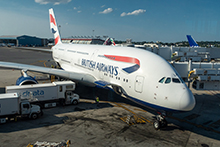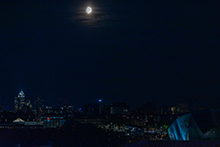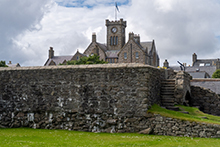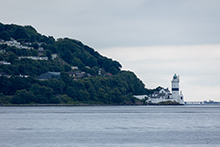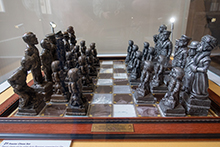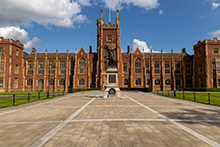In July 2024, we took an 11-day cruise around the British Isles. Departing from Amsterdam, we visited ports in England, Scotland, Northern Ireland, and Wales.
(Click on each group of photos below for larger versions.)
We flew from Boston to Amsterdam, arriving the day before our cruise was to depart. That gave us a little time to explore Amsterdam, though we were there in October 2023. The first stop was supposed to be Dover, England, but an issue with the ship meant we stayed overnight and the next day in Amsterdam before departing for the second stop, Invergordon, Scotland (thus bypassing Dover).
- Our flight from Boston on was on the upper deck of an Airbus 380. After a brief stop in London, we continued to Amsterdam
- We arrived in Amsterdam the next morning (time zones), and headed to the hotel. It was too early to check in, but we were able to leave our luggage, have lunch, and do a little sightseeing. We took a canal cruise which passed Montelbaanstoren, a 16th-century defensive tower. Once part of the city walls, the bells and a clock were added in 1606.
- We also cruised past the Basilica of Saint Nicholas, a grand Catholic church featuring many frescoes & stained-glass windows.
- Our hotel was right next to the cruise terminal. When we looked out the hotel window the next morning, the ship (Jewel of the Seas) was ready and waiting.
- We were supposed to depart around 6PM, but an issue with the ships controls meant we would spend the night and next day in Amsterdam. The photo is a view of the moon over Amsterdam at night, taken from the ship. Unfortunately, that meant skipping Dover, England, which was supposed to be the next port.
- We could come and go from the ship during the day in Amsterdam. We decided to visit the Rijksmuseum, which we didn't have a chance to do when we were in Amsterdam last October.
- The bridge across the street from the museum had a nice view of one of the many canals.
- One of the famous paintings at the museum is the self-portrait of Vincent Van Gogh, painted in 1887.
- Isaac and Rebecca, Known as 'The Jewish Bride' by Rembrandt, c. 1665 - 1669.
- Next is The Sampling Officials of the Amsterdam Drapers' Guild, Known as "The Syndics" by Rembrandt in 1662.
- A rock crystal dish, c. 1550 - 1575. In the 16th century, rock crystal was thought to be petrified water. This is why decorations often include depictions of marine creatures and other aquatic animals.
- A table clock in the shape of a tower, c. 1640. Not only do the dials indicate the time, but also the days and months of the year, the phases of the moon and the position of the constellations: an entire universe in miniature.
- Harpsichord, c. 1627. This exceptionally small harpsichord sounds a fifth above normal pitch and is the only one of its kind to have survived.
- Model of the Prins Willem, c. 1651. The real Prins Willem left the harbor of Middleburgh in 1651 for it's maiden voyage to the East Indies. The ship sailed to Batavia (Jakarta) a total of five times before sinking on its return home in 1662. (No survivors.)
- There was plenty more to see, but it was time to head back to the ship and get ready to depart (finally). The evening sky was very pretty as we cruised through the canal.
- Another photo of the full moon illuminated by the red sky as we traversed the canal on our way out of Amsterdam.
- Finally, we reached the locks at the end of the canal! Next is a day at sea on our way to Scotland.
After a day at sea, we visited three ports in Scotland. Invergordon (near Inverness and Loch Ness), Lerwick, and Greenock (near Glasgow). (Some of the older ports are too shallow for large cruise ships.)
- The first stop was Invergordon. Since we were near Loch Ness, the one souvenir Rachael asked for was a Nessie plushie. After we got it, I texted a photo to her. (After a little editing.)
- A view from our balcony of Invergordon, Scotland.
- Facing the opposite direction, the view was quite different.
- We took an excursion to various scenic spots near Invergordon, including a picturesque lake.
- We also stopped at a salmon run. Note the salmon trying to get to the top of the waterfall.
- Once they got past the waterfall, the rest of the swim upstream was somewhat easier.
- Next stop was Lerwick, the capital of Shetland, which is the northernmost region of the UK. The island was part of Norway from the 10th to 15th centuries.
- The ship anchored a little short distance from the port of Lerwick, so we used tenders to get to and from the port.
- A view of the port of Lerwick from the ship.
- We visited the Shetland Museum, which has a history of the island dating back 450 million years, before the European and American continents separated. It included many Viking artifacts, along with full scale models of the housing from centuries ago.
- After visiting the museum, we stopped at Fort Charlotte, built in 1674 and rebuilt in 1780. Based on the position of the cannon, the fort was well placed to defend Lerwick.
- As I was taking the photo of the cannon, the seagull wanted to pose in front of the ship. It clearly was not afraid of humans.
- Lerwick City Hall, viewed from Fort Charlotte.
- As we were leaving Lerwick, we passed by the Bressay Lighthouse on our way to our next stop.
- The large cliff outside of Lerwick is called Giants Leg. I made sure there was a boat in the foreground to provide a reference for the size of the cliff.
- Shetland is quite far north. This view of the sunset was taken a little after 10PM. At home, it's dark by then.
- The next stop was Greenock, Scotland, near Glasgow.
- Before our tour of scenic Scotland, we visited the Scottish Fire and Rescue Service Museum and Heritage Center. This museum included various antique fire apparatus. It was staffed by knowledgeable volunteers who could explain the history.
- Another antique fire engine.
- This engine is a little newer, including an internal combustion engine. Note the starter crank, though.
- Wallace was adopted by the Glasgow Fire Brigade in 1894 after he followed a horse-drawn fire engine taking part in a lifeboat demonstration. Wallace died in 1902, and his body was embalmed and put in a glass case at the Central Fire Station.
- Next, we took a tour through some of the scenic lakes in the area, which included a ferry across the bay. The next photo is a few of Greenock from the ferry.
- On the ferry, we also passed by the Cloch lighthouse.
- One of the stops on the tour was the "Rest and be Thankful Viewpoint at Loch Restil." The photo of the lake was taken from the viewpoint.
- Walking a few meters in the other direction at the same stop was a view of this picturesque valley. After this stop, it was back to the ship to depart for our next stop.
The next stop on our tour was Belfast, Northern Ireland.
- We took a shuttle to central Belfast, where we visited City Hall.
- City Hall had an extensive display of the history of Belfast. The hallway leading to the exhibits had some stained glass windows covering the history. Note the Titanic in the lower right of the window.
- The exhibit had quite a bit of information on the Titanic (it was built in Belfast) as well as many other aspects of Belfast's history.
- An example is this pewter chess set. The figures correlate to some of the Titanic passengers such as the owners of Macy's Department Store in NY, Isidor and Ida Straus. (They're the king and queen on the chessboard.)
- Next, we visited the historic Crumlin Road Gaol (prison) built in 1845. It was a working prison until 1996, when it was renovated and re-opened as a visitor attraction and conference center.
- This is a view of the tunnel connecting the prison with the courthouse.
- A view of a cell for women, c. 1846.
- A view of a cell for children c. 1846. Children as young as 7 could be incarcerated here.
- By the time the prison closed in 1996, conditions hadn't improved much. In fact, there were now two prisoners to a cell.
- On our way back to the ship, we stopped briefly at the much happier place, Queens University.
- It was time to depart Belfast. One common sight whenever we were in port was seagulls. Lots of seagulls.
After Belfast, the next stop on our cruise around the British Isles was Liverpool, England. Home of the Beatles.
- This statue of the Beatles was a short walk from the ship.
- We then visited Royal Albert Dock, also near the ship. The difference between high and low tide in Liverpool is extreme, making loading and unloading ships difficult. The dock opened in 1846, and was designed to make loading/unloading ships easier.
- Liverpool Mountain (at the Albert Dock) was inspired by naturally occurring Hoodoos (spires or pyramids of rock) and the art of meditative rock balancing. This 10-meter high sculpture consists of colored rocks, stacked vertically which seem to defy gravity.
- When we visited the Beatles statue there were just 2 guys from Australia there, so we had plenty of time to take pictures of each other in front of the statue. On the way back from the Albert Dock, it was a little more hectic.
- Next, we took a sightseeing trip around Liverpool. In the foreground is an equestrian stature of Queen Victoria. The background is the Wellington Column.
- We visited the Liverpool Cathedral, with some large and impressive stained glass windows.
- Another stained glass window at the Liverpool Cathedral.
- No tour of Liverpool would be complete without a stop at Penny Lane. Unfortunately, the original sign was stolen. Liverpool decided to paint the sign on the stone wall, but that was subsequently vandalized with peoples names and initials. Covering it with plexiglass helped.
- While the Titanic was built in Belfast, it's maiden (only) voyage started in Liverpool. Back on the ship, we were near the Memorial to the Marine Engine Room Heroes. This granite monument commemorates the 244 engineers who lost their lives while keeping things running in the 1912 Titanic disaster.
- On the way out of Liverpool, we passed Fort Perch Rock, a coastal defense battery built between 1825 and 1829 to protect the Port of Liverpool.
- One thing I noticed as we were leaving was huge windmill farm, providing power to the area.
Our last stop on this fun cruise was Holyhead, Wales.
- We took an excursion to historic Beaumaris Castle, in Beaumaris, Wales. Construction began in 1295 and ended in 1330. The castle was still incomplete though, because funding had become an issue.
- The castle had multiple walls. To the right is the exterior wall, with the moat on the other side. Then a green space, with an interior wall on the left. Almost a castle within a castle.
- In the middle was a large courtyard. The various rooms were in the stone structure surrounding the courtyard.
- Looking out one of the "windows" inside the castle, looking towards the wall on the opposite side of the courtyard.
- A view of one of the hallways deep inside the castle walls. Even during the day, the hallways were fairly dark, and we had to watch for steps.
- Of course the castle has a chapel, complete with stained glass.
- On the way back, we passed a number of scenic lakes.
- Back in Holyhead, where the ship was anchored, was a view of an old fort near the edge of the town.
- Reaching out from town was a long breakwater, with the Holyhead Breakwater Lighthouse at the end. The ship was fairly close to the lighthouse.
- Alas, it was time to head back to Amsterdam and fly home. As we left Holyhead, there were seagulls flying alongside the ship, as if to say "So long, and thanks for all the fish."
